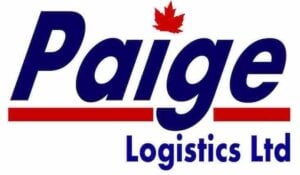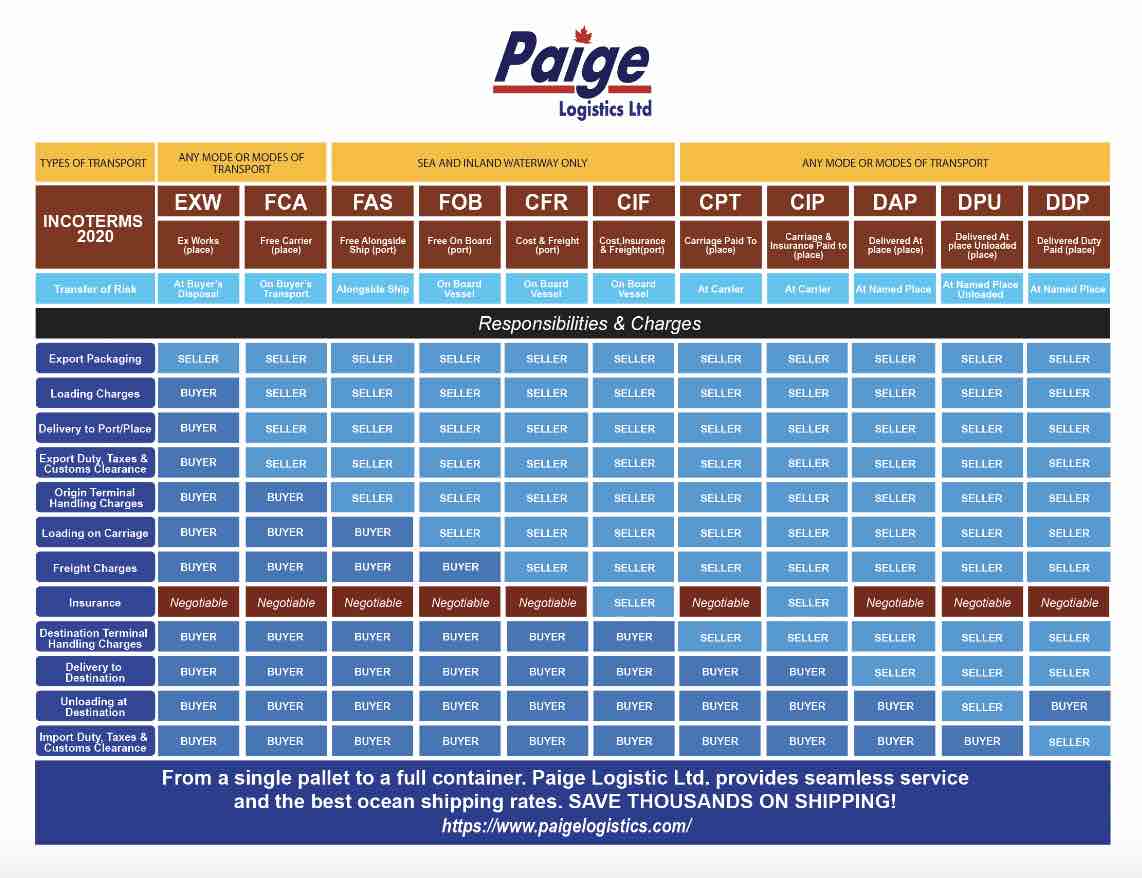What are Incoterms® 2020?
Incoterms® 2020 is a set of international trade terms developed by the International Chamber of Commerce (ICC). These terms are used in international trade to define the responsibilities of the buyer and seller in relation to the transportation of goods. Incoterms® 2020 consists of 11 terms, which can be grouped into two categories:
EXW (Ex Works)
FCA (Free Carrier)
CIP (Carriage and Insurance Paid To)
DAT (Delivered At Terminal)
DAP (Delivered At Place)
DDP (Delivered Duty Paid)
FAS (Free Alongside Ship)
FOB (Free On Board)
CFR (Cost and Freight)
CIF (Cost, Insurance and Freight)
CPT (Carriage Paid To)
The Incoterms® 2020 rules provide a common set of definitions and rules for the interpretation of trade terms used in international sales contracts. They help to reduce misunderstandings and disputes between buyers and sellers by clearly defining the responsibilities of each party in relation to the delivery of goods. Incoterms® 2020 is widely used in international trade, and it is important for businesses to understand and use these terms correctly in order to avoid misunderstandings and potential disputes.
Let's explore what it means to be a buyer or a seller in a DAP delivered at place Incoterms arrangement.
A Supplier’s Duties. Packaging for Export: Preparing Goods for Transportation Abroad.
Costs incurred by the buyer to have the merchandise loaded onto the truck at the seller’s warehouse are referred to as “loading charges.”
The cost of hauling or delivering the cargo to the export port or destination.
Everything that must be done to get the shipment out of the country legally, including payment of any export duties or taxes and clearance through customs.
OTHC stands for Origin Terminal Handling Charges, and these fees are the responsibility of the supplier.
Costs associated with loading cargo onto the carriage have to be borne by the vendor. Transportation expenses incurred by the seller in order to deliver the goods to the buyer.
The vendor is responsible for any Destination Terminal Handling Costs (DTHC). Once the shipment reaches the port of destination specified by the buyer, the seller is liable for making the remaining trucking arrangements necessary to deliver the goods to their final destination.
Duties of the Purchaser
Costs connected with unloading the product from the truck to the final destination, typically a warehouse, are the responsibility of the buyer.
All fees related with customs clearance and paying any applicable import duties or taxes are the exclusive responsibility of the purchaser. The expense of a customs examination, if one is necessary, will be borne by the buyer.
The Pros and Cons from the Purchaser’s Perspective
Advantages:
The buyer benefits greatly from shipping under DAP Incoterms since it clarifies who is accountable for which shipping-related costs. According to the ICC, once the products have been made available to the buyer, the buyer assumes full responsibility for the shipment. They would typically be given access to the load at the buyer’s storage facility. If there are any unexpected charges incurred during shipping, they will be covered by the vendor.
The DAP agreement is widely used since it places all transportation risk on the seller while imposing minimal accountability on the buyer.
DAP incoterm is useful for purchasers who need to keep track of high-priced commodities that must be reordered frequently from suppliers in order to avoid running out of funds. Under DAP Incoterms, the seller is responsible for transporting the goods to the buyer, and the latter is only obligated to pay for the shipment once the goods have arrived at their final destination.
Sellers can transport products to a bonded warehouse near the buyer’s location when they are regularly reordered or when the buyer guarantees a certain quantity. The local bonded warehouse would ship the cargo whenever the buyer is ready to reorder.
The buyer reaps tremendous benefits from this. Instead of waiting for the shipment to come from the seller’s origin, they can place smaller orders and have them fulfilled more quickly.
Disadvantages:
Despite the Incoterm’s clear definition that the buyer must pay for all import duty, taxes, and customs clearance, DAP is sometimes associated with unnecessary delays. In most transactions, the shipment will be cleared via customs before it reaches the buyer’s final location. The buyer is responsible for any additional fees associated with storage, dunnage, or release from detention.
Overall cost will be greater than if a buyer relied on their China 3rd party logistics provider or China freight forwarder, as is the case with all Incoterms where the seller carries both the risk and responsibility to move the cargo.
Some merchants may view DAP as a risk, particularly when shipping to new customers, and there are drawbacks for the seller to be aware of.
There is a high possibility of loss of cargo on the part of the seller due to the possibility that the buyer would refuse to pay import duties. Since sellers are aware of these dangers, they will likely need larger deposits or charge more for shipment in order to cover their costs.
When Should a DAP Contract Be Used?
The DAP agreement’s flexibility is one of its primary strengths, as it can be used in ways that are mutually advantageous to the buyer and the seller. This makes Incoterms a viable option if a seller is flexible about the terms of a deal.
DAP can help new importers reduce their exposure to risk and fulfill their legal responsibilities, but only if they are willing to pay a hefty premium. If you are a novice importer and the seller provides DAP Incoterms, you should check the pricing against those offered under FOB and CIF.
DAP may be a good choice for more seasoned importers looking to enhance cash flow, if their sellers are open to discussing the possibility. Here are some examples of situations when a buyer and a seller might come to an agreement on a DAP:
DAP could suggest that the buyer doesn’t have to pay until the shipment arrives at their designated location, such as a warehouse. Here, the customer pays for the goods the day they are delivered instead of waiting for them to arrive at a warehouse, freeing up cash that could be used elsewhere.
If both parties agree, the seller can send more stock to a warehouse near the buyer (often a bonded warehouse), from which the buyer can make immediate purchases. The only expenditures to the customer would be those associated with importing and unloading.
DAP incoterms may be able to provide an innovative solution that will help the customer save money on shipping costs if they want to import goods from more than one country.
Products purchased in China and destined for the United States and Canada might be sent together in a single container to a port convenient to both countries, such Seattle, Washington.
The buyer may specify that a bonded warehouse be used as the designated location. The shipment will be split in two once it arrives; half will be imported in the US, while the other half will be forwarded to Canada.
Even though this situation is exceptional, it exemplifies how DAP can provide innovative ways for buyers to handle logistics with vendors.
A buyer must notify their sellers whenever they agree to a DAP deal. The final destination should be specified in detail, and a mutually agreeable schedule should be established to guarantee that the seller makes every effort to avoid delivery delays. Before the cargo leaves the vendor, the buyer should schedule a quality inspection to discover any issues.
If there are any unanticipated problems with the export or import, the parties involved should discuss who will pay for the dunnage, detention, or storage costs.
F.A.Q.s Regarding the DAP Agreement
Can you explain the distinction between DAP and DDP?
The only real difference is who foots the bill for bringing the goods into the country. When using DDP, the seller is responsible for paying any and all applicable import taxes and duties and arranging for any necessary customs clearance. It is the buyer’s responsibility to pay any applicable import taxes or fees and to clear customs under DAP.
Can you explain the distinction between DAP and CIF?
The vendor is responsible for ocean freight forwarding costs and insurance under CIF. However, the shopper is responsible for all fees associated with the final leg of the journey, including destination handling and clearing (DTHC), local delivery and unloading, and import duty, taxes, and customs clearance.
With DAP, the buyer is responsible for only the unloading fees and any applicable import duty, taxes, and customs clearance.
Where does the tab for DAP incoterm shipping costs fall?
According to the Incoterms DAP, sea freight forwarding costs are covered entirely by the seller. Once the package arrives at the designated location, the only additional expenses incurred are those associated with importing the cargo and unloading the consignment.
If you want to know more about shipping incoterms 2020, you may look them up here. For further support for China Canada shipping we are here to help.
If you’re interested in connecting with the best freight forwarders in Canada, freight forwarder Canada to US, or for ocean shipping China to Canada you can check out:
An Integrated reference to incoterms for worldwide shipping, cross border shipping and more detailed Canada California shipping.
Stuck for finding the best freight forwarder China to Canada?
Shipping with Paige Logistics! Offering extended cross border shipping Canada to California.
2023 Global Leader In Shipping
Freight Carriers Association of a Canada
Ocean Freight Services China to Canada
International Fulfillment and Logistics

Author & Chief Executive Officer at Paige Logistics Ltd. → Experienced Operations Manager with a demonstrated history of working in the Transportation, Trucking and the Railroad Industry.


